The Skinny On Fishing Newport Harbor
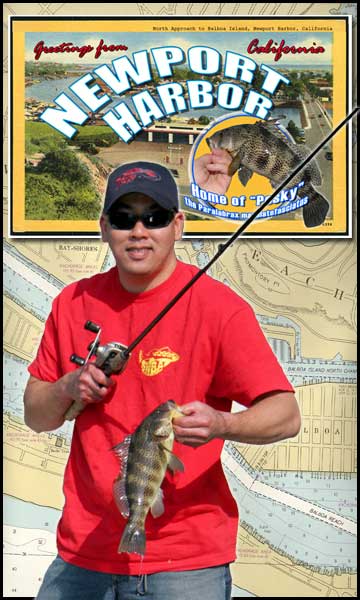 The 1st stop in the SWBA 2006 “Race for the Cup”
The 1st stop in the SWBA 2006 “Race for the Cup”
Newport Harbor is known as one of the finest small boat harbors in the world. It is as functional as it is beautiful. Boat slips line most of the shoreline, in addition to mid channel anchorage. All size recreational and commercial boats can be accommodated, from the smallest of rowboats to large luxury yachts. Private homes, from small beach houses to elegant estates, line the harbor’s contour.
Upper Newport Bay consists of marshlands, small sandbars, salt flats and sheer cliffs. This portion of Newport Bay has been left in its natural state to serve as a bird sanctuary and fishery habitat. An encircling pathway and a bike trail provide scenic vistas and quiet moments away from the normal hustle and bustle of Newport Harbor.
FOR ME, SCOUTING A NEW AREA BEGINS WITH A GOOD MAP…
Newport Harbor, California
No, not to figure out the fishing patterns, but to locate the launch ramp and strategically plan out my ingress and egress routes. Nothing sucks more than being lost amongst thousands of pissed-off morning commuters that have zero-tolerance for a lost fisherman and his boat doing four-point U-turns whilst trying to find a sign for the launch ramp.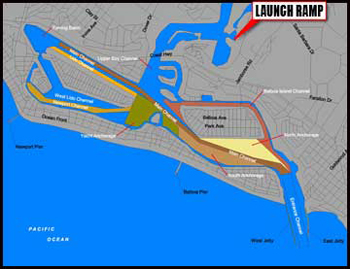
As for Newport Harbor, the launch ramp is located at the Newport Dunes RV Park – 101 N. Bayside Dr. , Newport Beach, CA 92660. The Park is open 24 hours a day, 7 days a week, and has the only public launch ramp in all of Newport Harbor. Launch fees are seasonal – $10. gets you in on a winter weekday, $15. for weekends and holidays. Summer rates jump to $15. and $20. Ramp is a solid three holer, but it can shrink to two or even one hole on super low tides. Tons of parking and never seems to get too crowded, unless there is a wedding going on. Although I have launched there upwards of 15 times, I still do not know where the public restroom is, so you are on your own in that department. Personally, after the hour-long coffee slurpin’ drive down from Burbank, I often seek refuge in the large flowery bush to the left of the walkway leading up to the Back Bay cafe… Speaking of the cafe, I understand it is quite good and they even do a nice Sunday brunch program. You can get further Intel on the cafe, launch ramp and RV Park at www.newportdunes.com or by calling (949) 729-1100.
Originally surveyed in the 1880’s, Newport Bay is a combination of two distinct bodies of water, Lower Newport Bay and Upper Newport Bay
The Lower Bay, referred to as the outer harbor, was formally a coastal lagoon formed between 1824 and 1862 due to sand deposition from the Santa Ana River. The Upper Newport Bay is essentially a submerged river valley formed by a precursor to the Santa Ana River.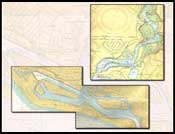
Today, to say that the lower bay is heavily urbanized would be an understatement to say the least. Over 70,000 people live within the 9,472 acres (14.8 square miles) of land area that surround the 600 acres (0.93 square miles) of the Lower Bay, that equates to 7.3 persons per acre.
Several species of marine mammals are common to the harbor and vicinity. They include the California sea lion, harbor seal, and several species of dolphins. Marine birds found in the harbor are primarily spring and fall migrants or winter residents.
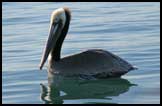 Year-round residents include several species of gulls, the Western Grebe, Brandt’s and Double-Crested Cormorants. Grebes. Seasonal migrants include Surf Scooters, Red-Breasted Mergansers, and Red-Throated Loons which can stop in to forage in the calm, open sub tidal waters of the harbor.
Year-round residents include several species of gulls, the Western Grebe, Brandt’s and Double-Crested Cormorants. Grebes. Seasonal migrants include Surf Scooters, Red-Breasted Mergansers, and Red-Throated Loons which can stop in to forage in the calm, open sub tidal waters of the harbor.
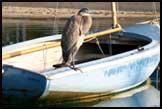 Other periodic inhabitants in Newport Harbor area are the California Brown Pelican, the California Least Tern, the American Peregrine Falcon, the Light Footed Clapper Rail, the Marbled Murrelet, the Western Snowy Plover, the Tidewater Goby, and the Pacific Pocket Mouse. Personally I have no idea what a Tidewater Goby is, but it sure sounds like some kind of twin tailed, go-to, hand-poured, powder-coated, sure-fire, super-scented bait to me.
Other periodic inhabitants in Newport Harbor area are the California Brown Pelican, the California Least Tern, the American Peregrine Falcon, the Light Footed Clapper Rail, the Marbled Murrelet, the Western Snowy Plover, the Tidewater Goby, and the Pacific Pocket Mouse. Personally I have no idea what a Tidewater Goby is, but it sure sounds like some kind of twin tailed, go-to, hand-poured, powder-coated, sure-fire, super-scented bait to me.
JUST SOME OF THE GAME FISH THAT INHABIT THE UPPER AND LOWER REGIONS OF NEWPORT HARBOR.
The following data and images are courtesy of Dr. Larry Allen and his associates at CSUN who have spent over 30 years collecting information and publishing it as a part of the Scientific Angler documentation project available from the Near shore Marine Fish Research Program website.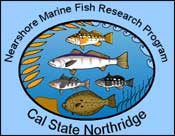
SCIENTIFIC NAME – Paralabrax clathratus,
family Serranidae (sea basses)
COMMON NAMES – Calico bass, bull bass, cabrilla (Mexico)
SCIENTIFIC NAME – Paralabrax nebulifer,
family Serranidae (sea basses)
COMMON NAMES – sand bass, sandies, cabrilla (Mexico)
SCIENTIFIC NAME – Paralabrax maculatofasciatus,
family Serranidae (sea basses)
COMMON NAMES – spotted sand bass, spotted bay bass, cabrilla pinta (Mexico)
SCIENTIFIC NAME – Atractoscion nobilis ,
family Sciaenidae (croakers)
COMMON NAMES – white seabass; seabass, corvina blanca (Mexico)
SCIENTIFIC NAME – Paralichthys califonicus ,
family Bothidae (Left-eyed flounders)
COMMON NAMES – California halibut, flatty, fly swatter (small), barn door (large), alabato, Monterey halibut, chicken halibut, southern halibut.
SCIENTIFIC NAME – Shyraena argentea ,
family Sphyraenidae (barracudas)
COMMON NAMES – Pacific barracuda, ‘cuda, barries, slimers, picuda (Mexico)
SCIENTIFIC NAME – Seriola lalandi ,
family Carangidae (jacks)
COMMON NAMES – Yellowtail, yellows, ‘tails, Jurel de aleta amarilla (Mexico)
SCIENTIFIC NAME – Paralabrax clathratus, family Serranidae (sea basses)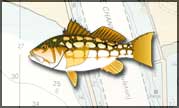
COMMON NAMES – Calico bass, bull bass, cabrilla (Mexico)
DISTRIBUTION – Kelp bass have ranged historically as far north as the mouth of the Columbia River and south to Bahia Magdalena, Baja California, Mexico. However, they are rare north of Pt. Conception. They are abundant in southern California waters including the shores all of the Channel Islands. They are typically found in shallow water (surface to 150 ft.) being closely associated with just about any kind of structure, including kelp.
SIZE & AGE – To 28.5 inches and 14.5 pounds. The oldest known kelp bass was 34 years old and 25 inches long. They are relatively slow growing sea bass with average size at age being:
5″ at 1 year; 10″ at 4 years; 15″ at 10 years and 23″ at 30 years.
DIET – Small fishes (including anchovies, sardines, surfperch, queen fish), squid, octopus, crabs, shrimps, and amphipods.
SCIENTIFIC NAME – Paralabrax nebulifer, family Serranidae (sea basses)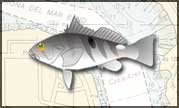
COMMON NAMES – sand bass, sandies, cabrilla (Mexico)
DISTRIBUTION – Barred sand bass range Santa Cruz south to Bahia Magdalena, Baja California, Mexico. They are rare north of Pt. Conception. Sand bass chiefly inhabit the shallow waters near the southern California mainland, but have be captured at depths as great as 600 feet. Young sand bass are abundant in very shallow water (5 to 30 feet). The name “sand bass” is a somewhat unfortunate since they are usually closely associated with sand/rock interfaces of deep reefs and artificial structures and a rarely found out over sandy expanses.
SIZE & AGE – To 26 inches and 11.1 pounds. The oldest known barred sand bass was found to be 24 years old. They are relatively slow growing sea bass with average size at age being:
5″ at 1 year; 10″ at 4 years; 16″ at 10 years and 23″ at 24 years.
DIET – Small fishes (including anchovies, sardines, midshipman), squid, octopus, crabs, and clams.
SCIENTIFIC NAME – Paralabrax maculatofasciatus, family Serranidae (sea basses)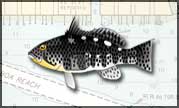
COMMON NAMES – spotted sand bass, spotted bay bass, cabrilla pinta (Mexico)
DISTRIBUTION – Spotted sand bass have ranged historically as far north as San Francisco Bay and south to Mazatlan, Mexico. Healthy populations also occur into the most northern portions of the Gulf of California (Sea of Cortez). In most years, however, they are rarely seen north of Santa Monica Bay. In southern California waters, spotted bass are restricted to shallow, warm water areas such as bays, harbors and quiet, protected areas of the coast where eelgrass, surf grass, and rock relief occurs.
SIZE & AGE – To 24 inches and 6.75 pounds. The oldest known spotted sand bass was 14 years old and 18 inches long. They are very fast growing sea bass with average size at age being:
10 ” at 1 year; 10″ at 4 years; 14″ at 10 years and 15″ at 14 years.
DIET – In southern California, clams, crabs, and small bay fishes such as gobies, kelpfish and top smelt.
SCIENTIFIC NAME – Atractoscion nobilis , family Sciaenidae (croakers)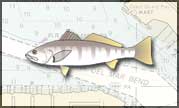
COMMON NAMES – white seabass; seabass, corvina blanca (Mexico)
DISTRIBUTION – Juneau, Alaska to southern Baja California Gulf of California. Principal area of abundance between Pt. Conception and Ballenas Bay, Baja California.
SIZE & AGE – To 5 feet and 83 pounds. The oldest fish encountered in the early study was 13 years of age based on scale rings. I aged a 72 pound white seabass at 17 years using its otoliths. My guess is that they probably live to about 20 years. A just legal sized fish of 28 inches total length is about 5 years old according to scale aging.
DIET – Squid, anchovies, sardines, pelagic red crabs, and other small fishes.
SCIENTIFIC NAME – Paralichthys califonicus , family Bothidae (Left-eyed flounders)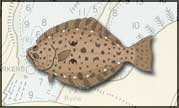
COMMON NAMES – flatty, fly swatter (small), barn door (large), alabato, Monterey halibut, chicken halibut, southern halibut.
DISTRIBUTION -California halibut occur from Magdalena Bay, Baja California, to the Quillayute River, British Columbia. A separate population occurs in the upper Gulf of California.
SIZE & AGE – Males first mature when 2 or 3 years of age, but females do not mature until 4 or 5. A 5 year old fish may be anywhere from 11 to 17 inches long.
SCIENTIFIC NAME – Shyraena argentea , family Sphyraenidae (barracudas)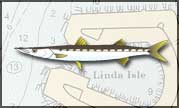
COMMON NAMES – Pacific barracuda, ‘cuda, barries, slimers, picuda (Mexico)
DISTRIBUTION – Kodiak Island, Alaska to southern Baja California though most common from Pt. Conception south to about Punta Eugenia in most years. In El Nino years, they can be found in numbers off central California. Barracuda are pelagic fish which occur near shore typically around kelp beds and reefs.
SIZE & AGE – To 48 inches and about 17 pounds. The oldest known California barracuda was 11 years old and 41 inches long. Barracuda grow very fast in early life reaching a length of 14 inches at one year. At the legal catch size, most barries are 4 or 5 years old. Females grow a bit faster and apparently live longer than males with most fish over 10 pounds being females.
DIET – As is typical with most pelagic predators, barracuda feed mainly on anchovies, sardines, small mackerels, and squids.
SCIENTIFIC NAME – Seriola lalandi , family Carangidae (jacks)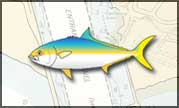
COMMON NAMES – Yellowtail, yellows, ‘tails, Jurel de aleta amarilla (Mexico)
DISTRIBUTION – Worldwide in subtropical and temperate seas. In California yellowtail are found from Santa Barbara south, most commonly in the summer and fall. Most of the southern California yellowtail probably migrate up from the Cedros Island area off mid-Baja California. Off southern California, many of the offshore islands and banks hold resident populations of large fish.
SIZE & AGE – To 5 feet and 80 pounds. The oldest known yellowtail was 12 years old and four feet long. They are very fast growing fish with average size at age 1 being 20 inches in length and 3.8 lbs. in weight; at age 5 being 31 inches in length and 13.2 lbs. in weight.
DIET – Sardines, anchovies, jack and Pacific mackerel, squid and pelagic red crabs.
More 411 on them Newport “Spotties”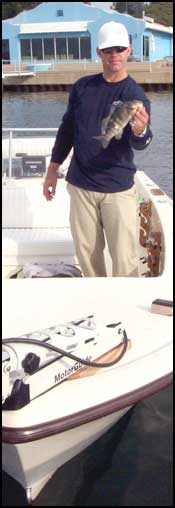
…THE STARS OF NEWPORT
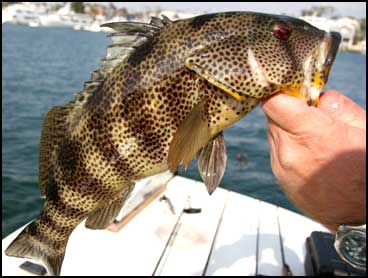 This marine species was described in 1868 by Steindachner who gave it the scientific name of Paralabrax maculatofasciatus. This long, tongue-twisting name represents a composite of Greek and Latin words meaning the fish which is ‘near ‘(para-) ‘Labrax’ (a European bass) and is both ‘spotted’ (maculato-) and ‘banded’ (fasciatus). According to the American Fisheries Society, officially, its accepted common name is spotted sand bass, but among anglers it also goes by the aliases of spotted bass, spotted bay bass, spotteds or simply spotties.
This marine species was described in 1868 by Steindachner who gave it the scientific name of Paralabrax maculatofasciatus. This long, tongue-twisting name represents a composite of Greek and Latin words meaning the fish which is ‘near ‘(para-) ‘Labrax’ (a European bass) and is both ‘spotted’ (maculato-) and ‘banded’ (fasciatus). According to the American Fisheries Society, officially, its accepted common name is spotted sand bass, but among anglers it also goes by the aliases of spotted bass, spotted bay bass, spotteds or simply spotties.
Supplement:
SPOTTED SAND BASS – A History of the Fishery
as published by:
The California Department of Fish and Game “California’s Marine Living Resources – A Status Report – 2001
The spotted sand bass (Paralabrax maculatofasciatus) has quickly gained popularity with near shore anglers for its aggressive behavior and fighting ability. Recreational angling for the spotted sand bass has seen a dramatic increase in the last 10 years, resulting in angling tournaments that target spotted sand bass exclusively
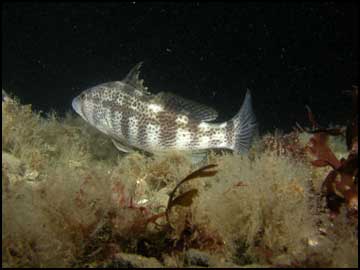 Not considered quality-angling fare in the 1930s and the early 1940s, the spotted sand bass began to gain in popularity with shore and bay anglers in the mid-1950s. During that period, almost all landings were made from shore or by small skiff anglers fishing within the bays of southern California. Concern regarding the growing pressure on this little-known resource by sport anglers resulted in the formulation of conservation measures for the spotted sand bass. These measures include the restriction on commercial exploitation of the genus Paralabrax in 1953, and in 1959, the adoption of a 10-fsh bag-limit and a 12-inch size-limit on kelp bass and barred sand bass, as well as the spotted sand bass. Unfortunately, early landing data of spotted sand bass were either lumped in with the other Paralabrax landings or not adequately reported. For these reasons, accurate landings numbers for this species are difficult to obtain and no substantial data were recorded until the mid-1970s.
Not considered quality-angling fare in the 1930s and the early 1940s, the spotted sand bass began to gain in popularity with shore and bay anglers in the mid-1950s. During that period, almost all landings were made from shore or by small skiff anglers fishing within the bays of southern California. Concern regarding the growing pressure on this little-known resource by sport anglers resulted in the formulation of conservation measures for the spotted sand bass. These measures include the restriction on commercial exploitation of the genus Paralabrax in 1953, and in 1959, the adoption of a 10-fsh bag-limit and a 12-inch size-limit on kelp bass and barred sand bass, as well as the spotted sand bass. Unfortunately, early landing data of spotted sand bass were either lumped in with the other Paralabrax landings or not adequately reported. For these reasons, accurate landings numbers for this species are difficult to obtain and no substantial data were recorded until the mid-1970s.
Surveys conducted by the Department of Fish and Game on skiff fishing estimated that the annual catch of spotted sand bass in southern California waters ranged from 12,790 to 23,933 fish between 1976 and 1981. Additional estimates of sport catch, based on data from boat and shore fishing, indicated that between 53,000 and 170,000 spotted sand bass were taken per year from 1980 to 1989. No landing data were recorded from 1990 to 1993; however, from 1994 to 1999 between 37,000 to 347,000 spotted sand bass were landed either by shore or small skiff fishermen, a substantial increase from the landings numbers recorded in the 1980s. This rise in landings can be attributed to an increased interest in recreational fishing in shallow near shore waters and consequential increase of angling pressure on the resource. Additionally, with the introduction of oat-tube technology and the popularity of ocean kayaks, the accessibility to spotted sand bass habitat has opened up dramatically. This accessibility has generated interest in the spotted sand bass as a challenging recreational fishery.
Although the annual catch of spotted sand bass for the record keeping period has been considerably lower than the catches of the kelp bass and the barred sand bass, the increase in fishing pressure and landing numbers is cause for concern due to their restricted habitat in southern California waters. Early DFG shore surveys revealed that due to its restricted bay habitat and geographically localized populations (San Diego Bay, Mission Bay, Newport Bay, Anaheim Bay), the spotted sand bass fishery may have been viewed as a less important sport fishery by the public. However, recent increases in landing numbers, indicate that this view may be changing.
Status of Biological Knowledge
The spotted sand bass has an historic range from Mazatlan, Mexico to Monterey, California. However, this species is rarely seen north of Santa Monica Bay. Included within that range are substantial populations in the Gulf of California. Southern California populations are typically restricted to sandy or mud bottom habitat within shallow bays, harbors and coastal lagoons that contain eelgrass, surf grass and rock relief. These areas act as warm-water refuges for this generally subtropical species.
Spotted sand bass grow rapidly during their first two years. Some specimens may reach as much as 8.8 inches at the end of their first year and there is no significant difference in growth rates between males and females.
Spotted sand bass spawn in the warm summer months, from late May to early September and the presence of multiple sized oocytes in gravid females indicates that this is a multiple spawning species. During the spawning season, spotted sand bass form breeding aggregations at or near the entrances of bays in southern California. Observations on spawning in the wild have shown that females initiate the spawn by leaving the bottom and entering the water column to release eggs. At the time of release, multiple males may dart in to fertilize the eggs. The observed episode was extremely brief and once completed all participants return to the bottom.
The eggs and larvae are pelagic and enter the plankton in the coastal waters, settling out of the water column at 25 to 31 days. Juvenile spotted sand bass (greater than two inches) have several dark stripes running longitudinally along their sides, making them similar in appearance to juvenile barred sand bass. Juveniles of this species occupy eelgrass beds and can share these nursery environments with their sympatric juvenile relatives, the barred sand bass and the kelp bass. Adults usually occupy a depth of two to 30 feet, however specimens have been taken from waters as deep as 200 feet in the Gulf of California.
The spotted sand bass appears to have a complex mating system. Individual populations within southern California display varied patterns of reproduction. In San Diego Bay, protogynous hermaphroditism, where individuals start their lives as females and after a period of time change to males occurs. In Anaheim and Newport Bays, gonochorism, a pattern where the individuals do not change sex is found, resulting in an essentially equal distribution of males and females throughout the age and size class in the population.
During the spawning season, male and female spotted sand bass exhibit a definite sexual color dimorphism. Males will display a whitish chin color and an overall high-contrast, body coloration, while females will display a yellow chin and a darker body.
Male spotted sand bass mature at 7.8 inches and about 1.4 years and females mature at about 6.7 inches and about one year of age. The impact of potential sex change, if any, on these values is unknown.
In California waters, adult spotted sand bass have a diet that consists primarily of crabs and clams, with fishes forming a relatively small component of their overall food compliment. The crab component consists of brachyuran crabs, and the dominant bivalve in the diet is the jackknife clam.
While spotted sand bass can reach 14 years-of-age, most have a maximum life span of about 10 years. The current world record spotted sand bass is an individual caught in 1995, which measured 23 inches and weighed 6.7 pounds. This record fish was 10 years old.
Significant morphological and genetic differentiation has occurred among spotted sand bass populations throughout their geographic range. The Gulf of California populations appear to be distinct from those on the Pacific coast. Those populations in southern California also appear to be genetically distinct from those in the mid-Baja, Pacific coast. This subpopulation structure indicates that spotted sand bass exhibit limited dispersal from their restricted habitats.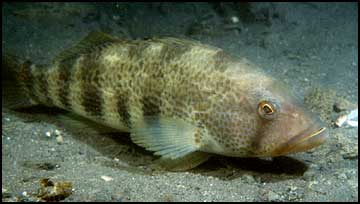
So what do “spotties” like to eat…
SPOTTIE FOOD?
by Dr. Larry Allen
What do spotties eat anyway? Well, after two years of investigation we have pretty much managed to confirm what we already knew, but that is not to say that we knew everything! The general answer to the question is that spotted sand bass, like most fish, will eat anything that is edible, available, and that they can get their mouths around. In other words, they are what ecologists call opportunistic predators. The result of this “down the hatch” strategy is that usually a wide range of food items is taken by the fish, if you look at a lot of stomachs. Overall, the 543 spotties examined contained over 13 groups of different types of marine animals, from crabs and clams to snails, shrimps, brittle stars, algae, and even rocks. However, even with this wide variety of possible food items, it is not unusual to have one, two, or three food items which dominate the diet in numbers and weight.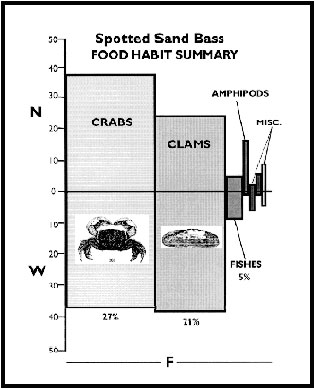
The graph accompanying this article summarizes the results of our food habit study on spotties. This figure presents food data in the way which has become standard for dietary analysis in fisheries research. The graph combines three very important aspects of the food items found: percent number (N), percent weight (W), and percent frequency of occurrence (F). The total number (or %N) of individual items in each category is usually a good indicator of how important a particular food item is to the diet of the fish. However, many small items may not be as important as one large thing. Therefore, we also must consider how much something weighs (%W). If something occurs in large numbers and/or mass, but only occurs in one or two of all the fish, then the overall importance of that item diminishes. For this reason, frequency of occurrence is also very important and must be considered when evaluating the diet of any particular species. Fish biologists usually combine all three of these factors in an index called the Index of Relative Importance (IRI).
IRIs can be visualized very nicely using the type of graph presented here. Put simply, the relative importance of each type of food item is proportional to the size of the rectangles on the graph. When presented this way, the conclusions are obvious. Spotted sand bass from southern California eat crabs, clams and some fish.
The presence of a large number of clams in the diet of spotties has been mentioned several times in my past articles. These clams included, predictably, jack-knife clams and common littlenecks. Fish are not surprising either. After all, do we not fish for them with fish-like swimming lures? The most interesting find of all, however, is how important crabs seem to be to their diet. Why aren’t we all fishing for spotties with mud crabs or crab-imitating lures? Mike Leopold of Maywood Marine once gave me some crab lures to try – should I warn him to get ready for a run on his stock?
When it comes to tackle don’t take these little monsters lightly.
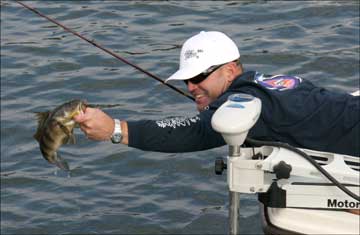 Eric Bent (EB) successfully fishes one out from around his trolling motor
Eric Bent (EB) successfully fishes one out from around his trolling motor
I have heard many story of spinnerbait blades being bent, mangled and even broken completely off from the crushing bite these pesky guys deliver. When the bite comes, it comes very hard and very quick – pays to be ready.
Just some basic recommendations…
Spool up with some quality abrasion resistant line, something in the 8lb – 10lb category on your favorite medium, to medium heavy rig. A casting set up will provide the best presentation if working the docks and pilings, and will give you the hook set and back bone to move the fish off the structure quickly – this is important as the barnacles and razor mussels will cut you off in an instant.
The magic three – although there is always a unique situation, for the most part it seems the staple baits for fishing this harbor are – in order of preference and appearance – swimbaits; crankbaits and spinnerbaits.


Hands down, the coolest part of fishing Newport has got to be the variety of platforms that can be used…
If you are land-locked, there are several public piers located throughout the harbor providing fishing access. Float tubing is a great way to target a specific area, although a little on the cool side during the winter months. Kayaks are great platform and there are a couple places to launch and rent them from. Motorboat rentals are readily available and a comfortable way to get around the harbor. Private boats in the 12ft – 20ft range outfitted with a bow mounted trolling motor is an excellent way to get around and target specific areas where mobility is often times the key to getting a bite.
Warren and James work the nooks and crannies aboard The Wallflower.
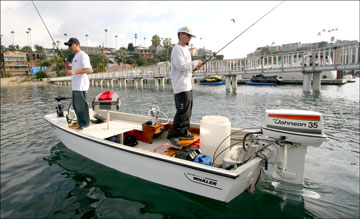 A truly classic ride – The Wallflower is a 13 ft. 1977 Boston Whaler complete with the original 35 horse Johnson outboard motor and classic cable-pulley steering system. Custom designed for tournament fishing with a 15 gallon aerated live well; dual fish finders with GPS; a VHF radio; a custom built casting platform with pedestal seat; and a 54 lb. thrust Motor Guide trolling motor powered by Optima batteries.
A truly classic ride – The Wallflower is a 13 ft. 1977 Boston Whaler complete with the original 35 horse Johnson outboard motor and classic cable-pulley steering system. Custom designed for tournament fishing with a 15 gallon aerated live well; dual fish finders with GPS; a VHF radio; a custom built casting platform with pedestal seat; and a 54 lb. thrust Motor Guide trolling motor powered by Optima batteries.
When fishing for spotties, tides do matter…
Flood, ebb, slack, moon rise, moon set, moon underfoot, moon overhead … it all matters…
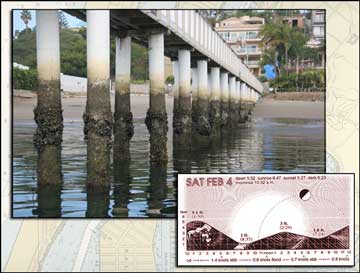 Take all that’s been said about diet and spawning behavior and wrap it around the movement and clarity of the water. Some like a steep swinging tide with lots of water movement, while others prefer a longer more gradual movement. Some like it flooding and some like it ebbing. In the end the best advice I have ever heard for fishing the tides is to plan your route accordingly. Meaning that it’s not the best idea to work your way into the back of the bay during an ebbing tide because you will find yourself at the farthest back point in very thin water – not necessarily the best fishing conditions. Instead try and plan out a route that uses the tidal flow as a baseline. If you prefer 8-10 ft., dirty water with moderate movement then use the tides and depth charts to position you there. These fish really do key on some type of movement and it really sucks to be in the wrong place at the wrong time – no matter how fast your boat is, idle speed is the max throughout the harbor, so it definitely pays to plan.
Take all that’s been said about diet and spawning behavior and wrap it around the movement and clarity of the water. Some like a steep swinging tide with lots of water movement, while others prefer a longer more gradual movement. Some like it flooding and some like it ebbing. In the end the best advice I have ever heard for fishing the tides is to plan your route accordingly. Meaning that it’s not the best idea to work your way into the back of the bay during an ebbing tide because you will find yourself at the farthest back point in very thin water – not necessarily the best fishing conditions. Instead try and plan out a route that uses the tidal flow as a baseline. If you prefer 8-10 ft., dirty water with moderate movement then use the tides and depth charts to position you there. These fish really do key on some type of movement and it really sucks to be in the wrong place at the wrong time – no matter how fast your boat is, idle speed is the max throughout the harbor, so it definitely pays to plan.
Amongst the elite inner-circle of anglers there is a single spot where you can find a quality bite during the slow slack tide period… I understand the carnitas breakfast burrito is exceptionally hard-hitting! Tie up at the public ramp just south of the Balboa ferry dock and you’re within a stones throw.
An added bonus to this stop is that once you get you order in at the Island Grill, you can slide north a couple yards and check out JD’s Big Game Tackle Shop…
JD’s Big Game Tackle
James Shamblin hoists up a nice ebb tide spottie caught between docks on a spinnerbait one in one of the canals behind Lido Island.
Although hardly comprehensive here is a quick resource list for the harbor…
Launch ramp –
www.newportdunes.com or (949) 729-1100.
Weather – http://www.talesofbalboa.com/weathereye/index.html
Tides – www.tidelog.com or (415) 868-2909
Emergency –
Coast Guard is on call 24/7 on VHF-16, telephone 800-221-8724; Orange County Harbor Patrol – 949-723-1000;
Harbormaster on 24/7 call on VHF -16 and 2182 kHz, telephone 949-723-1002
Fuel dock –
The fuel docks are on either side of the channel by the Balboa Ferry landing just west of the Pavilion. There are 4 locations. Balboa Ferry Landings: north and south side
Island Marine Fuel-76 – 949-673-1103
Hills Boat Services, Inc.-Standard – 949-6750741
Newport Landing – 949-729-1100
Tackle –
JD’s Big Game Tackle (949) 723-0883
Boat rental –
Anchors Away (714) 673-3372; Balboa Boat Rental (714) 673-7200
Kayak rental –
www.southwindkayaks.com or (949)-261-0200
References and Acknowledgements
The Near shore Marine Fish Research Program, California State University Northridge Director: Larry G. Allen, Ph.D.
Horn. M. H. and L. G. Allen 1981. Ecology of fishes in Upper Newport Bay, California: seasonal dynamics and community structure. Calif. Dept. Fish Game, Mar. Res. Tech. Rep. No. 45, 102 pp.
Allen, L. G., T. Hovey, M. Love, and T. Smith 1995. The life history of the spotted sand bass (Paralabrax maculatofasciatus) within the Southern California Bight. CalCOFI Reports 36: 193-203.
Hovey, T. M. and L. G. Allen 2000. Reproductive patterns of six populations of the spotted sand bass, Paralabrax maculatofasciatu, from Southern and Baja California. Copeia, 2000(2): 459-468.
Hovey, T. E. and L. G. Allen 2001. Spotted Sand Bass. In: Leet, W.S., C.M. Dewees, R. Klingbeil, E.J Larson (eds). California’s Living Marine Resources: A Status Report. Calif. Dept Fish Game, U. C. Agri. Nat. Res. Pub. SG01-11, 592 pp.
The Scientific Angler Collection (1992 – 1995)

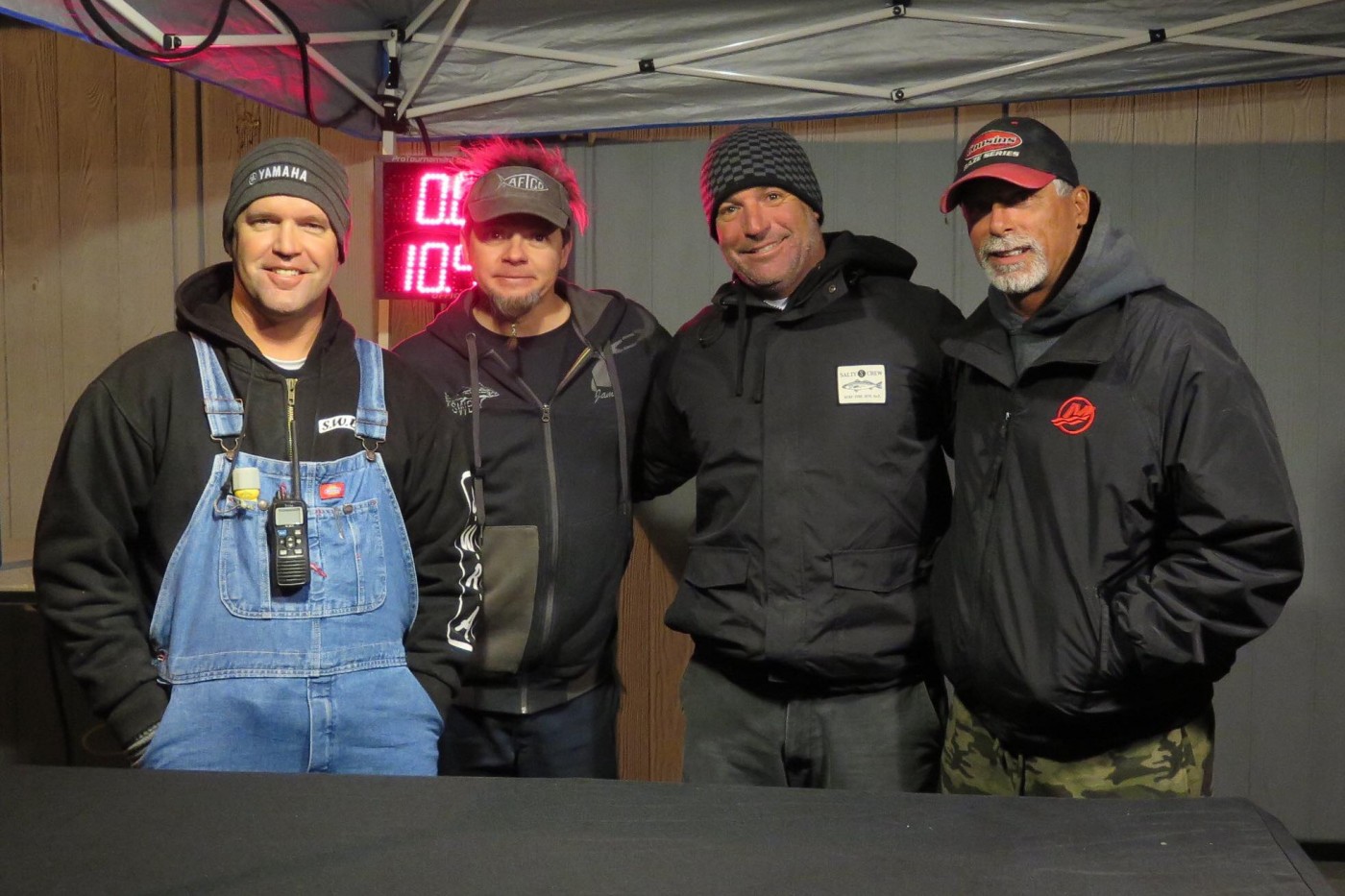

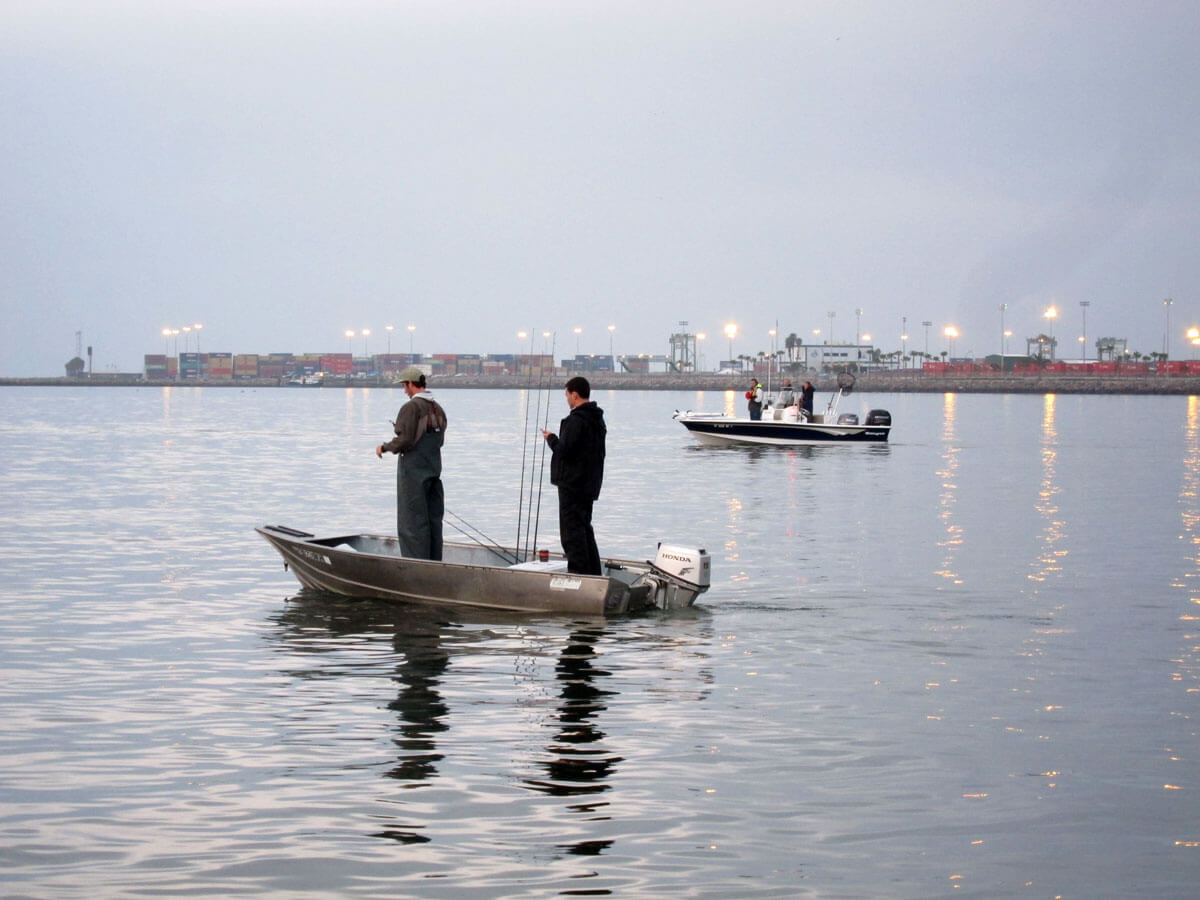
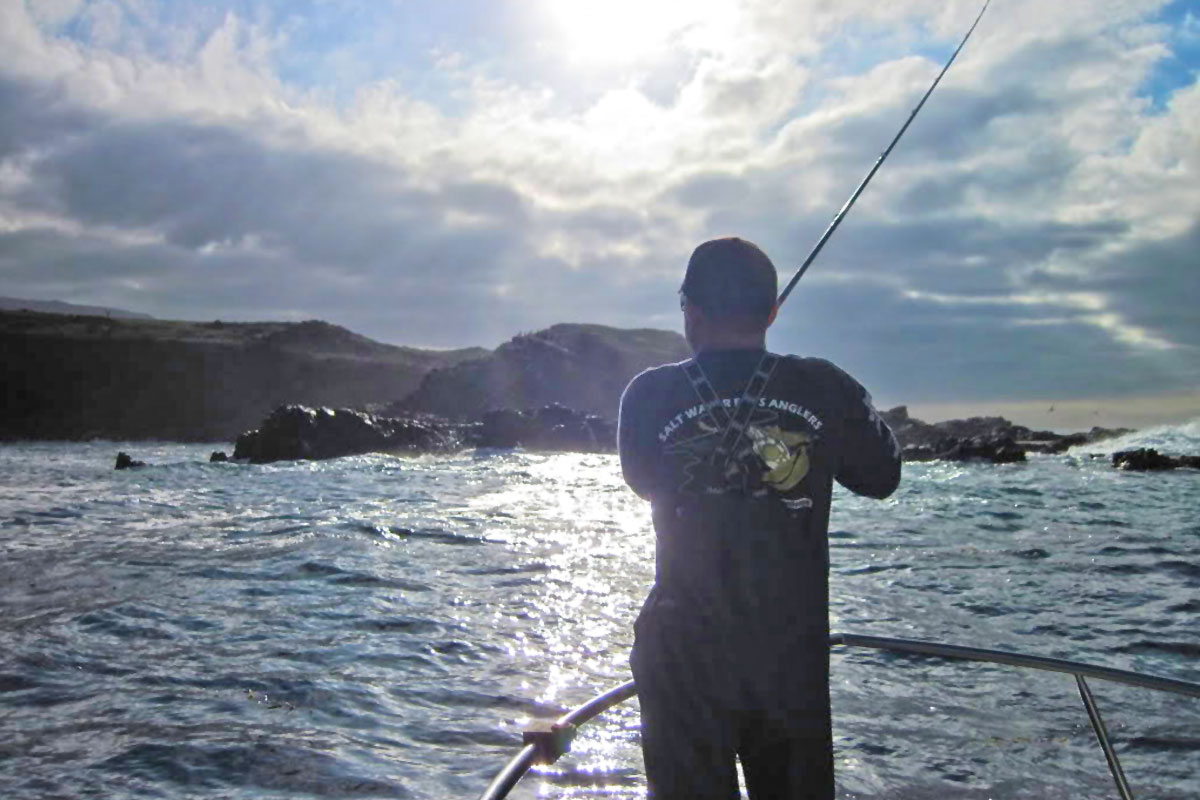
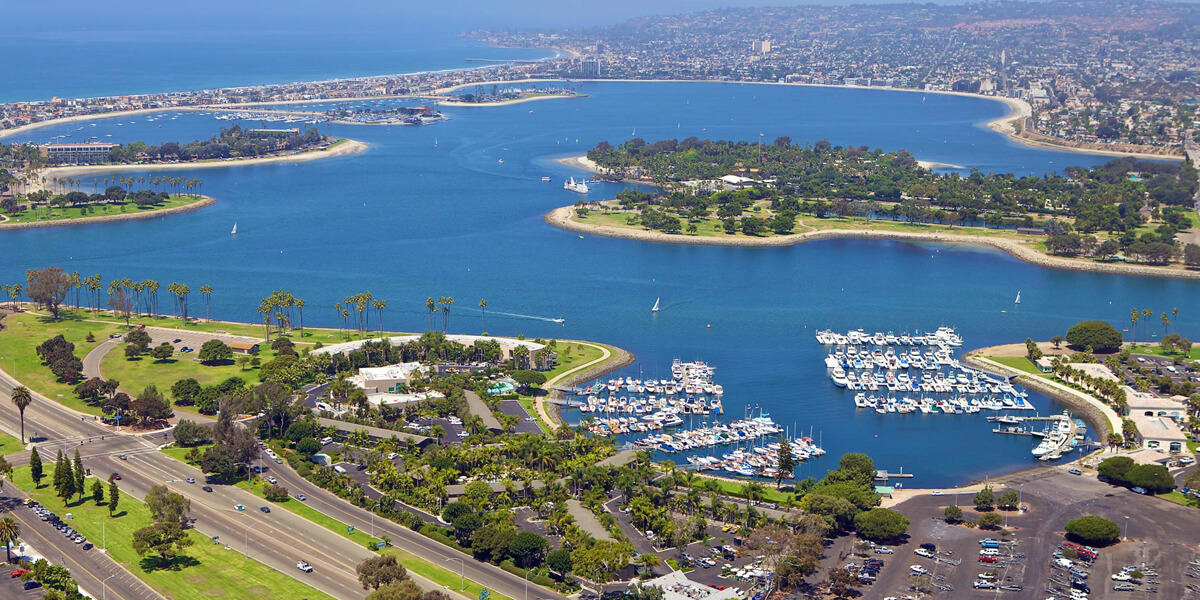
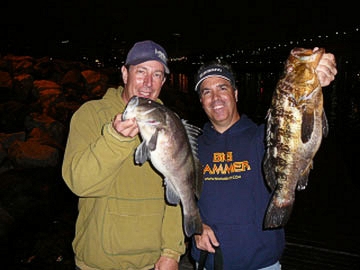

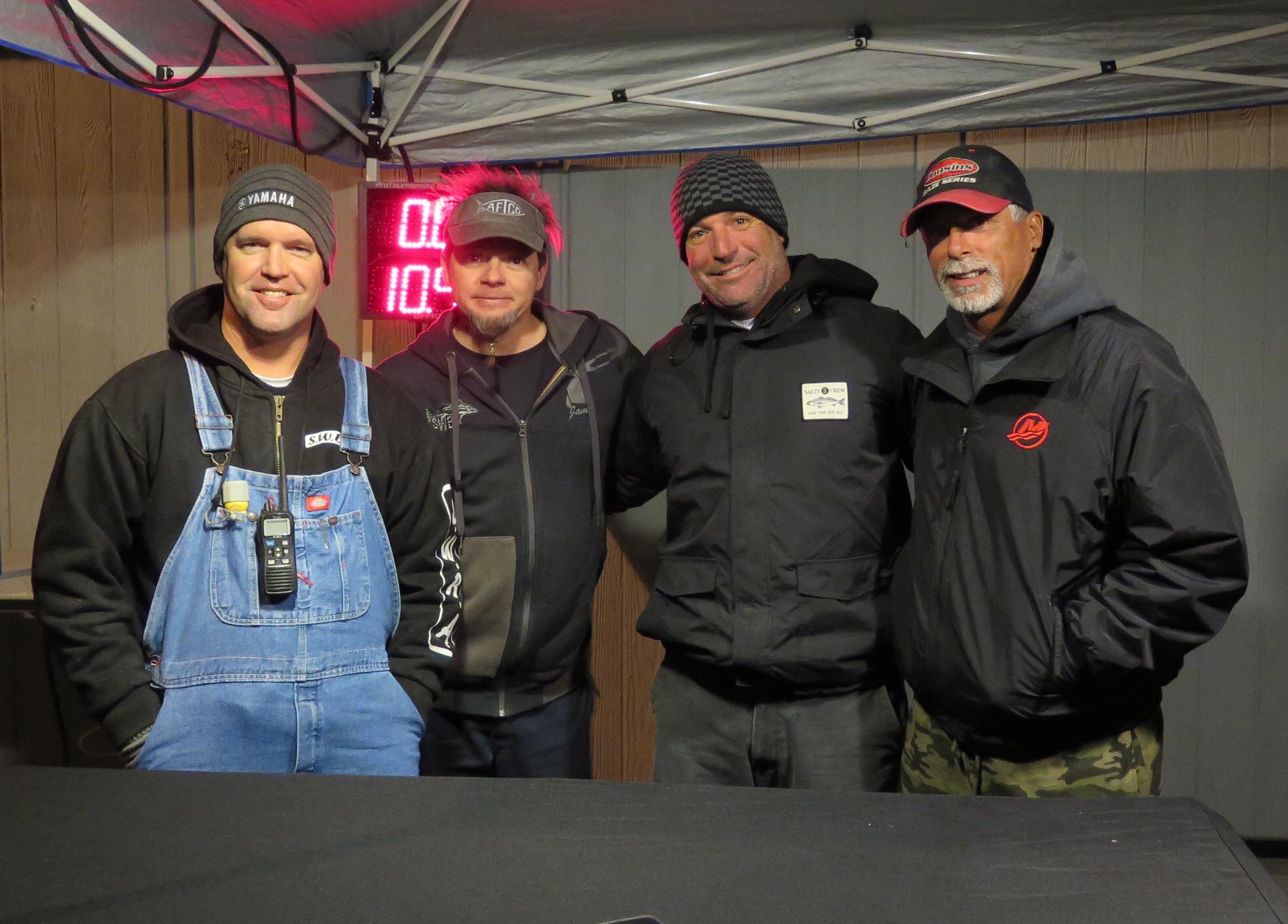
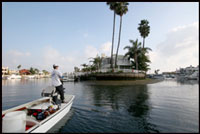
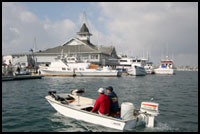
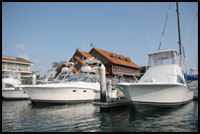
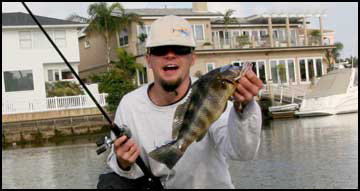

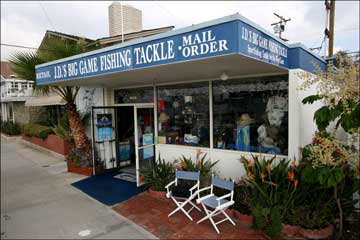






Got something to say?